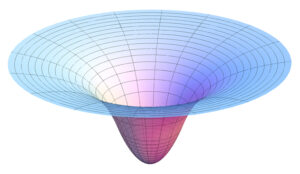Table of Contents
Gravitational potential energy is the energy that an object possesses or acquires as a result of a change in its position when it is in a gravitational field. In layman’s terms, gravitational potential energy is energy that is related to the gravitational force of gravity. When a body of mass (m) is displaced from infinity to a point within the gravitational influence of a source mass (M) without being accelerated, the amount of work done in displacing it into the source field is stored as potential energy. This is referred to as gravitational potential energy.
It is symbolised by the letter Ug. We know that a body’s potential energy at a given point is defined as the energy stored in the body at that point. If the body’s position changes as a result of the application of external forces, the change in potential energy is equal to the amount of work done on the body by the forces. The work done by the gravitational force is independent of the path taken for a change in position, making the force a conservative force. Furthermore, all of these forces have some potential. At infinity, the gravitational influence on a body is zero, so potential energy is zero, and this is referred to as a reference point. Gravitational potential is defined as the amount of work required to move a unit test mass from infinity into the gravitational influence of a source mass. Simply put, it is the gravitational potential energy of a unit test mass.
⇒ V = U/m
⇒ V = -GM/r

Dimensional Formula of Gravitational Potential
The Gravitational Potential dimensional formula is given by,
[M0 L2 T-2]
Where,
M stands for mass.
T = Time L = Length
Gravitational Potential (V) = Work done × [Mass]-1 . . . . (1)
Work done = Force × Displacement
W = M × a × Displacement
W = [M1 L0 T0] × [M0 L1 T-2] × [M0 L1 T0]
The work done dimensional formula = [M1 L2 T-2] . . . . . (2)
Furthermore, the mass dimensions = [M1 L0 T0] . . . . (3)
When we substitute equations (2) and (3) into equation (1), we get
Gravitational Potential = Work done × [Mass]-1
Or, V = [M1 L2 T-2] × [M1 L0 T0]-1 = [M0 L2 T-2].
As a result, Gravitational Potential is represented dimensionally as [M0 L2 T-2].
FAQs
What causes gravitational potential energy to be -ve?
Because bringing an object closer to the Earth requires a negative amount of work, gravitational potential energy is always a negative number when using this reference point.
Is gravitational potential considered a vector?
Gravitational potential is a scalar quantity with a negative value rather than a vector quantity. To compute the value, divide the gravitational potential energy by the mass. J/Kg is the SI unit.
Can gravitational potential be beneficial?
Gravitational potential is always a negative quantity. You can escape the planet if you have enough kinetic energy or speed. There would be no bound systems if the gravitational potential was positive.
What is the difference between a gravitational field and a gravitational potential?
The gravitational field can be defined most usefully in terms of the gravitational potential U. The potential U due to a point mass m at a given point P at a given distance r from m is defined as the work required by gravity to move a unit mass from infinity to the final position P.





